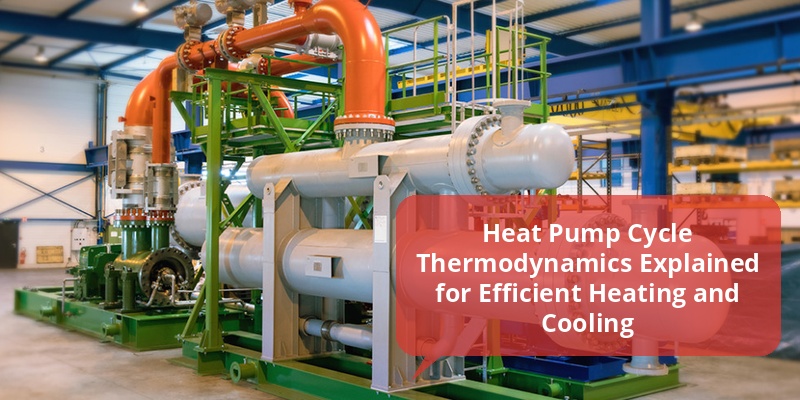The heat pump cycle is a critical concept in modern HVAC systems, providing efficient heating and cooling solutions by transferring heat rather than generating it. This process leverages thermodynamic principles to move heat from one location to another, maximizing energy efficiency. Understanding the thermodynamics behind the heat pump cycle helps optimize performance, reduce energy costs, and support sustainable energy use. The following summary table outlines the key components and functions within a heat pump cycle.
| Component | Function | Thermodynamic Role |
|---|---|---|
| Evaporator | Absorbs heat from the environment | Heat absorption via refrigerant evaporation |
| Compressor | Increases refrigerant pressure and temperature | Work input to raise refrigerant enthalpy |
| Condenser | Releases heat to indoor space | Heat rejection via refrigerant condensation |
| Expansion Valve | Reduces refrigerant pressure and temperature | Thermodynamic throttling to prepare refrigerant for re-evaporation |
The Basics of Heat Pump Cycle Thermodynamics
A heat pump functions by circulating a refrigerant through a closed loop that absorbs and releases heat at different stages. The system consists of four main components: the evaporator, compressor, condenser, and expansion valve. The cycle operates based on the laws of thermodynamics, specifically involving heat transfer and work energy.
The refrigerant absorbs heat from a cooler area and releases it into a warmer space, effectively moving heat against its natural flow, assisted by mechanical work. This mechanism makes heat pumps more energy-efficient than traditional electric heaters.
Key Thermodynamic Processes in the Heat Pump Cycle
Evaporation Process
The cycle begins in the evaporator where the refrigerant absorbs heat from the outside air or ground. At low pressure, the refrigerant evaporates, changing from a liquid to a vapor while absorbing heat. This phase change is an isothermal process, allowing the refrigerant to extract heat efficiently from the environment at low temperatures.
Compression Process
The compressor then increases the pressure and temperature of the vaporized refrigerant, which requires external work input, typically electrical energy. This process is an adiabatic compression that raises the enthalpy and temperature of the refrigerant, preparing it to release heat indoors.
Condensation Process
In the condenser, the hot, high-pressure refrigerant vapor releases heat to the indoor air. The refrigerant cools and condenses into a high-pressure liquid while transferring thermal energy to the heated space. The condensation is essentially an isothermal heat rejection process that warms indoor air efficiently.
Expansion Process
The expansion valve reduces the pressure and temperature of the refrigerant liquid before it re-enters the evaporator. This throttling process is isenthalpic, meaning enthalpy remains constant while pressure drops, causing the refrigerant to cool and be ready for the next cycle.
Thermodynamic Efficiency and Coefficient of Performance (COP)
Coefficient of Performance (COP) is a key metric for evaluating heat pump efficiency. It is the ratio of heat output to work input and varies depending on operating conditions. A high COP indicates better efficiency and lower operating costs.
Typical heat pump systems have a COP ranging from 3 to 5, meaning the system delivers three to five times more thermal energy than the electrical energy consumed.
Heat Pump Cycle in Heating and Cooling Modes
Heat pumps can reverse their cycle using a reversing valve to provide both heating and cooling. In heating mode, the system absorbs heat from outdoor sources and releases it indoors. In cooling mode, this process reverses, absorbing indoor heat and rejecting it outside.
This reversible operation makes heat pumps versatile and cost-effective for year-round climate control.
Factors Affecting Heat Pump Cycle Performance
- Source Temperature: The temperature of the heat source (air, ground, or water) significantly affects performance; warmer sources improve efficiency.
- Refrigerant Type: Refrigerant properties influence the thermodynamic cycle, environmental impact, and energy efficiency.
- System Design: Efficient compressors, heat exchangers, and control systems optimize the thermodynamic cycle.
- Installation Quality: Proper sizing and installation ensure the system operates under optimal conditions.
Advanced Thermodynamic Cycles and Innovations
Modern heat pumps incorporate innovations like variable speed compressors, enhanced refrigerants, and hybrid systems to improve thermodynamic efficiency. Some systems use multi-stage compression or ejector cycles to further optimize the heat transfer process.
Integration with renewable energy sources, such as solar and geothermal, enhances performance and reduces carbon footprints.
Applications of Heat Pump Thermodynamics in the USA
Heat pumps are increasingly popular across the United States for residential, commercial, and industrial heating and cooling due to their energy efficiency and environmental benefits. Government incentives and regulations promote heat pump adoption to reduce greenhouse gas emissions.
Cold climate heat pumps are specially designed to operate effectively even in harsh northern US winters, expanding the usability of heat pump technology nationwide.
